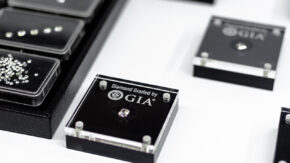Roger Dery is a hands-on lapidarist; he likes to travel to mining communities to buy the rough stones he later transforms into cut gems back in the US. One of his favorite places to source them is east Africa, and he has made more than 40 trips to the region. It was during those trips that he began to see the untapped potential of the local industry and what it could do for the people living there.
“I saw the stark difference [of having] even a little bit of economic increase coming from gem mining: New roads and infrastructure, more businesses and commerce, improved education and healthcare,” he says. “[As the majority] of east African colored-gemstone mines are artisanal, this very small influx of cash was literally life-changing for families.”
Wanting to bring more investment to the mining communities in the region, he and his wife Ginger started laying the groundwork in 2010 for what would become Gem Legacy.
No strings attached
The charity was officially founded in 2018 as a nonprofit to aid the development of miners, with its donor base split fairly evenly between consumers and jewelry trade members. Its initiatives include training in gemology and faceting, as well as providing tool kits and safety equipment for miners. It also funds schooling for miners’ children and local orphans. To date, the organization has raised more than $400,000.
Much of the work feels like the sort of community investment that mining companies now do, yet Gem Legacy has no commercial interests. This has earned it a positive reception from residents, according to Bjorn Sune Merisheki, the group’s director of east African initiatives.
“When visiting mining operations for the first time, they are surprised to find out that we do not expect to purchase gems or have a discount in future in exchange for our community involvement,” says Sune Merisheki, a second-generation tanzanite miner and gem cutter who now splits his time between his homes in Tanzania and Michigan. “That is followed by relief, since they understand the gift is free, without strings attached for the future.”
Professional development of miners is a key focus for Gem Legacy. Sune Merisheki himself is a graduate of a gemological training center the charity supports in Arusha, Tanzania. He feels the east African gem industry is “drastically under-developed,” and that investment in training will help miners better understand the value of what they are extracting.
“Gem Legacy has committed itself to miner and broker education because there is broad confusion about pricing factors and even gem identification,” he says. “There’s a few reasons why gemological knowledge is so important: To ensure [miners] are obtaining fair prices for their gems; to protect international buyers entering and being misled about the identity of a gem; to increase the positive reputation of the east African gem industry; and to protect the local gem industry from internal bad actors.”
The region’s gem trade is maturing, but it is a slow process. Gem Legacy recognizes this, but hopes, as Sune Merisheki puts it, “to be the wind under the wings of east African colored-gemstone mining’s growth and maturity.”
Their funds at work
The charity is keen to point out that 100% of donations go to the miners. To date, Gem Legacy’s running costs have been covered by contributions from its board of directors, which include jewelry editors Peggy Jo Donahue and Monica Stephenson, former Gemological Institute of America (GIA) global business development director Craig Selimotic Danforth, and Melissa Quick, president of retailer Steve Quick Jewelers in Chicago, Illinois.
This year marked the launch of Gem Legacy Adventures, a travel company offering wildlife safaris and mine visits. The profits from these trips go toward funding Gem Legacy’s work. When it comes to general fundraising, the group tries to help donors visualize the impact of their donations by letting them sponsor particular objectives, such as a tool kit or a training scholarship.
“Financial transparency is something the board of directors doesn’t take lightly,” says Dery. “We believe part of that is providing our donors with budgets for how much a commitment truly costs us on the ground. We want them to know exactly how their dollars are spent, and [to] have confidence in their donation.”
Besides courting corporate contributors, Dery encourages stores to enlist their customers: “Retail jewelers are an army of ambassadors to the jewelry-buying public and have the power to tell a remarkable story about the power of colored gemstones to positively impact families, communities and economies.”
Image: Gem Legacy | gemlegacy.org



